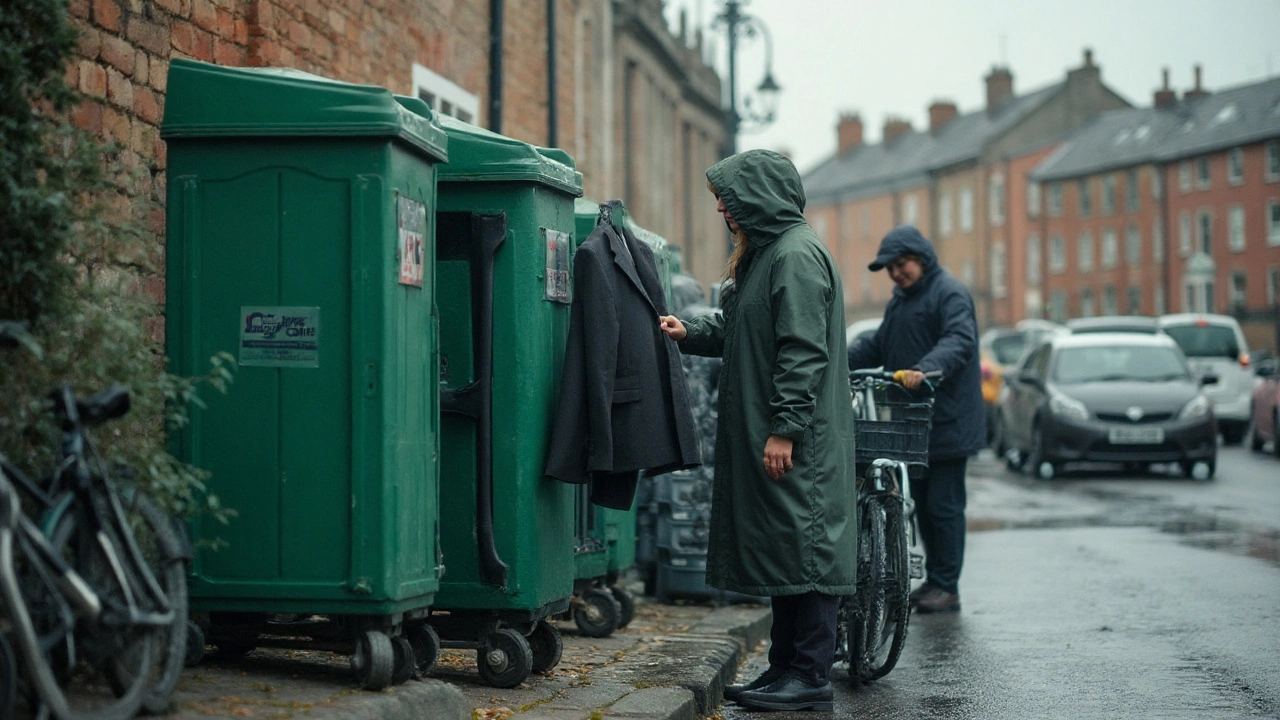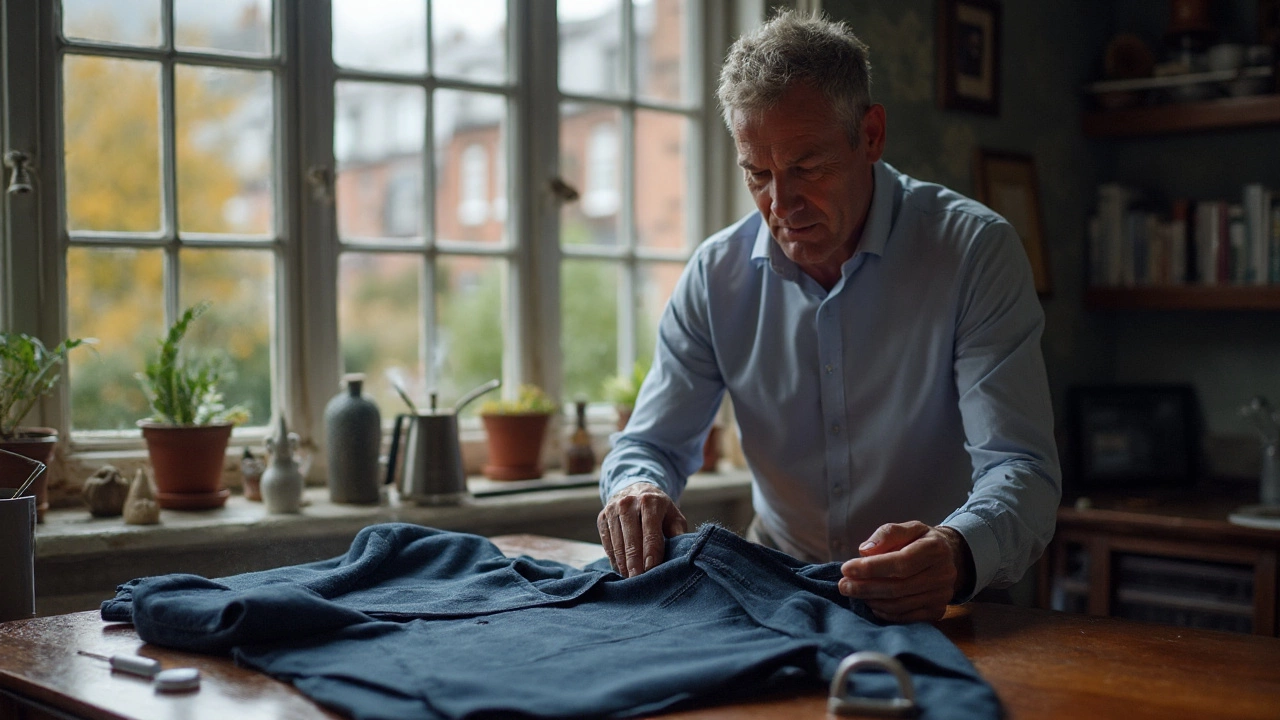If you wear suits in Ireland, you know the struggle: Atlantic rain, damp commutes, radiator drying, and that quick hop from the office to the pub. At some point, you ask the uncomfortable question: when do you throw away a suit-and when do you save it? This guide gives you hard signals, Irish-specific costs, and smarter options than the bin, so you can act with confidence.
Suit is a two- or three-piece tailored outfit (jacket, trousers, sometimes waistcoat) designed for business or formal wear; common fabrics include pure wool (240-320 g/m²), wool blends, and polyester; constructions range from fused to half- and full-canvas; typical lifespan in Ireland spans 2-8 years depending on fabric, construction, frequency of wear, and care.
TL;DR
- Keep it if repairs are under one-third of the suit’s replacement cost and the fabric still has body.
- Retire it if shoulders collapse, the seat shines through, or moth holes appear on visible panels.
- Dry clean sparingly; steam and brush more-Irish humidity can ruin a suit, not just stains.
- Donate wearable suits to SVP or Oxfam Ireland; recycle unwearable textiles at council banks.
- Expect 5-8 years from good wool; 2-4 from cheap fused polyester in regular rotation.
What “end of life” looks like in Ireland
In the Irish climate, suits age faster from moisture, salt air (coast commutes), and frequent layering. Public transport and long car sits kill the trouser seat and elbows. Radiator drying causes shine and delamination. So the signs here often show up as collapsed shoulders, shiny bum, bubbled fronts, and out-of-shape trousers-long before seams actually burst.
Blazer is an odd jacket (not part of a matching set) usually in navy or textured cloth; more forgiving to wear and repair; can outlast trousers because it avoids seat abrasion. It’s worth separating your expectations: a blazer can live on when the matching suit jacket would be a mismatch without its trousers.
Tuxedo is a black-tie evening suit defined by satin facings and a formal cut; worn rarely, so it often lasts decades if stored well and kept moth-free. A tux is a special case-low wear means long life, but one moth hole can still end it.
How long should a suit last in Ireland?
Rules of thumb based on wear and build quality:
- Good wool (half- or full-canvas), worn once a week: 5-8 years.
- High-street fused polyester or thin blends, worn once a week: 2-4 years.
- Occasional event suit (weddings, confirmations, interviews): 10+ years, if stored dry and moth-safe.
The Woolmark Company notes that wool naturally resists odour and recovers its shape after rest. That’s why you can rotate two wool suits weekly in Dublin and still get years out of them. Polyester traps heat and can go shiny quickly, especially on office chairs and car seats.
Wool tweed is a textured woolen cloth, often Donegal tweed, known for durability (heavier weight 300-450 g/m²) and rich speckling; performs well in damp climates and resists wrinkles. A tweed suit feels heavier but shrugs off Irish weather better than ultralight tropical wool.
Polyester is a synthetic fiber used in budget suits; low cost and crease resistance, but prone to sheen, heat build-up, and limited tailoring options; lifespan shortens with frequent wear. If your everyday suit is a poly blend, plan earlier replacement.
10 signs it’s time to retire your suit
- Shoulder collapse: padding or structure has flattened or shifted; tailoring won’t restore it cleanly.
- Shiny seat or elbows: abrasion has polished the fibers; that sheen won’t reverse.
- Bubbling on lapels or fronts: fused interlining has delaminated, often after radiator drying or harsh pressing.
- Moth holes on visible panels: small holes near lapels or cuffs kill formality; patching looks obvious.
- Frayed trouser crotch with thin fabric: if the cloth has lost strength, a patch is a short-term fix at best.
- Puckered or distorted lapels: steam and press won’t restore the original roll if the canvas or fusing is compromised.
- Seam strain and missing seam allowance: if previous alterations ate the allowance, there’s nowhere to go.
- Permanent odour or set-in stains: if dry cleaning can’t shift it without damaging the cloth, it’s done.
- Lining shredded beyond repair: a full reline can cost close to a budget suit; think twice unless the exterior cloth is excellent.
- Fit beyond practical alteration: more than two sizes up or down changes the garment’s architecture, not just its measurements.
Fabric and construction: why some suits die young
Construction determines how a suit ages. A fused front is cheaper but susceptible to bubbling; canvas keeps shape and can be steamed back to life.
Canvassed construction is a tailoring method where a floating canvas (often horsehair blend) is stitched between the cloth and lining; half-canvas reinforces chest and lapels; full-canvas runs throughout the front for better drape and longevity. Canvas costs more, but it’s the difference between a jacket you can refresh and one that sags forever after a wet morning on the Luas.
Weight matters too. Lighter suits (below 240 g/m²) are lovely in a warm boardroom but get blown about in Galway wind and wrinkle easily in Dublin drizzle. Medium weights (260-300 g/m²) are the Irish sweet spot most of the year.
Irish brands and what to expect
Local makers understand the weather and wear patterns.
Magee 1866 is an Irish heritage brand from Donegal known for tweed tailoring; typical off-the-rack suit prices in 2025: ~€595-€795; durable cloths with texture that hides wear and resists creasing. A Magee tweed will outlast a budget fused suit, even if you wear it to the Galway Races and into a busy session afterward.
Louis Copeland & Sons is a Dublin tailoring house offering made-to-measure and alterations; custom suits commonly range €900-€2,000+ in 2025; strong aftercare and practical alteration advice. If a Copeland suit fits well and has canvas, repairing linings or seams can be worth it years down the line.
Repair vs replace in Ireland: simple math
Use this rule: if total repair costs exceed one-third of replacement value, replace. Two exceptions: sentimental pieces and high-quality canvas suits.
- Hemming trousers: €15-€25
- Taper legs: €20-€35
- Seat and crotch repair: €25-€45
- Take in/let out jacket sides: €35-€65
- Shorten sleeves (from cuff): €25-€45
- New lining (jacket): €120-€180
- Re-canvas: rarely offered; uneconomical on budget suits
- High-street replacement suit: €150-€300
- Quality Irish tweed suit: €595-€795
- Made-to-measure replacement: €900-€2,000+
Prices reflect typical 2025 quotes around Dublin, Cork, Galway. For precision, ask your local alterations specialist or a tailoring house-many Irish shops will quote on WhatsApp after a few photos.
When dry cleaning helps vs hurts
Dry clean sparingly. In Ireland’s damp, over-cleaning flattens wool and stresses adhesives. Steam and brush more often; dry clean only after spills, odour, or at end of season before storage. Hang to dry naturally after rain-never on a radiator. The Irish Environmental Protection Agency has noted textiles as a fast-growing waste stream; cleaning less and keeping suits longer helps.

Storage that actually extends life
- Use a shaped wooden hanger; avoid metal wire.
- Air suits for 24 hours post-wear; brush nap with a clothes brush.
- Store in a breathable garment bag, not plastic.
- Add cedar blocks or moth sachets; vacuum wardrobes seasonally.
- Keep off radiators; heat leads to bubbling and shine.
Where to donate or recycle in Ireland
If it’s still presentable: donate. If it’s not: recycle textiles. Here’s where to start:
- Charity shops (e.g., SVP, Oxfam Ireland, local hospice shops): suits in wearable condition are welcome, especially tuxedos and interview-friendly navy/charcoal.
- Interview charities: organisations like Dress for Success Dublin can use smart suits in good condition.
- Textile banks at civic amenity sites: for torn or stained suits; check your county council site for supported banks.
Quick test: would you confidently meet a client in it? If yes, donate. If no, recycle.
| Path | Typical Cost | Time | Best When | Red Flags | Where to Go |
|---|---|---|---|---|---|
| Repair | €15-€180 | 1-10 days | Fabric still strong; issues are fit, hem, small tears, seat repair, lining | Collapsed shoulders, bubbling, severe shine | Alterations specialists; tailoring houses |
| Replace | €150-€2,000+ | Same day to 6 weeks | Fused jacket bubbled; major fit changes; worn-thin cloth | Sentimental attachment can skew logic-be honest | High-street, Irish brands, made-to-measure |
| Donate | €0 | Same day | Clean, unstained, wearable suits | Visible moth holes, odour | Charity shops, interview charities |
| Recycle | €0-€5 (site fees vary) | Same day | Unwearable textiles | None-better than landfill | Civic amenity textile banks |
Event-specific judgment calls
Weddings in Ireland: if the navy suit looks tired in photos (shine, shoulder collapse), consider renting or upgrading; you’ll revisit the album for years. For the Galway Races or Punchestown, you can get away with bolder tweeds and patterns-wear makes them look better, not worse. Interviews in Dublin’s tech and finance: crisp, modern fit matters; don’t risk a bubbled lapel.
Quick decision tree
- Check structure: are shoulders and lapels clean? If no, retire/replace.
- Check fabric: any shine, thinning, or moth damage? If yes, retire or recycle.
- Check fit: within 1-2 sizes of your current body? If yes, alterations can work.
- Cost check: are repairs under one-third of replacement? If yes, repair.
- Use case: do you need it for a key event? If yes and quality is mid/low, consider upgrading.
Special case: the tuxedo
Because a tux is worn rarely-debuts, winter balls, charity galas-it can last decades if stored properly. Dry clean after big events, air, then seal in a breathable bag with moth deterrent. Replace only if satin facings are worn or the fit is beyond what a skilled tailor can adjust. Rental is a sensible option if you wear black tie once every few years.
Related concepts to explore next
- Suit fit basics: shoulder width, jacket length, and trouser break.
- Alteration limits: which seams carry workable allowance.
- Irish dress codes: wedding guest, black tie, business formal vs smart casual.
- Fabric science: why wool behaves better than synthetics in damp air.
- Care gear: steamers, clothes brushes, breathable garment bags.
A note on halo pieces and sustainability
Keep one excellent suit if you work mostly smart-casual. Reach for it during interviews, funerals, or formal meetings. The Environmental Protection Agency in Ireland has highlighted textile waste as a problem; prolonging the life of a quality suit and recycling worn-out ones is a small but real way to cut landfill. Buy less, buy better, care well.
Next steps
- Do a five-minute inspection tonight: shoulders, lapels, seat, crotch, hems.
- List repairs and get two quotes-one from a local alterations shop and one from a tailoring house.
- Clean, press, and donate wearable suits this week; bag and recycle anything unwearable.
- Plan a rotation: two suits for weekly wear, ideally wool, medium weight. Rest each between wears.
- Set up storage: cedar blocks, breathable bags, and a proper hanger per jacket.

Frequently Asked Questions
How many years should a good wool suit last in Ireland?
With weekly wear and proper rest, a well-made wool suit typically lasts 5-8 years in Ireland. If it’s half- or full-canvas and you steam/brush instead of over-cleaning, 8-10 is realistic. Heavy Donegal tweed can last longer because the cloth is tougher and hides wear. Polyester blends, worn as often, tend to top out at 2-4 years.
What repairs are worth paying for, and which aren’t?
Worth it: hems, tapering, seat reinforcement, small seam repairs, modest waist adjustments, and replacing loose buttons. Sometimes worth it: a new jacket lining if the exterior cloth and construction are high quality. Not worth it: fixing a bubbled fused front, rebuilding collapsed shoulders, or major re-cutting more than two sizes-you’re chasing diminishing returns.
Is dry cleaning after every wear a bad idea?
Yes. Dry cleaning strips oils and can flatten wool, especially in damp Irish weather where suits don’t dry as fast. Steam and brush after most wears; dry clean only for spills, odours, or seasonal storage. Always air the suit first and keep it away from radiators, which can cause shine and delamination in fused suits.
Should I donate a suit with minor wear to Irish charities?
Yes-if it’s clean, odour-free, and presentable. Navy and charcoal are especially useful for interviews and office wear. If there are visible moth holes, heavy shine, or major stains, skip donation and use textile recycling. Bag the suit and label it clearly so the sorter doesn’t have to guess.
Can a tailor fix a shiny trouser seat?
Not really. Shine is abrasion damage where the surface fibers have flattened or worn. A tailor can reinforce the seat or recut the trousers if there’s generous seam allowance and extra cloth, but the shiny area itself won’t turn matte again. If the shine is significant, consider replacing the trousers or the suit.
What’s the best way to store a suit in Ireland’s damp climate?
Use a shaped wooden hanger, brush and air after wear, then store in a breathable garment bag with cedar or moth deterrents. Keep suits away from radiators and damp corners. If your wardrobe backs onto a cold exterior wall, add space behind the garments and consider moisture absorbers during winter.
Are Irish tweed suits acceptable for business settings?
Depends on the office. In many Irish workplaces, a muted Donegal tweed in navy, brown, or charcoal is fine, especially outside strict finance and law. The texture also hides wear and travels well in the rain. For conservative meetings or interviews in Dublin’s finance core, stick to smooth worsted wool in navy or grey.
What’s a fair budget for a long-lasting suit in Ireland?
If you wear a suit weekly, aim for a mid-tier wool suit around €400-€800 from a reputable maker; expect 5-8 years if cared for. If you need a sharp suit a few times a year, a €200-€350 high-street option is fine, but plan for earlier replacement. If fit and longevity are priority, made-to-measure from an Irish tailoring house is a smart long-term play.
How do I tell if my jacket is canvassed or fused?
Pinch the cloth and lining at the chest and gently roll them-if you feel a third layer moving independently, that’s canvas. Fused jackets feel like one solid layer. Also check the lapel roll: a natural, soft roll usually indicates canvas. If you’re unsure, ask a tailor; they can tell in seconds.
Final note: Ireland’s climate is tough on tailoring, but smart choices-good wool, proper storage, and timely repairs-make a suit earn its keep for years. And when it’s time, donating or recycling keeps it out of landfill and puts it to better use.
Blazer Mentioned above as an odd jacket; separates extend wardrobe life when trousers wear out.
Tuxedo Mentioned above as black-tie attire; low frequency of wear equals longer lifespan, provided moth protection is in place.
Wool tweed Mentioned above as durable Irish-friendly cloth; ideal for colder months and coastal towns.
Polyester Mentioned above as budget cloth; expect earlier shine and limited alteration scope.
Canvassed construction Mentioned above; canvas helps a jacket recover after wet commutes and heavy wear.
Magee 1866 Mentioned above as an Irish brand with resilient tweeds; suits priced mid to upper tier in 2025.
Louis Copeland & Sons Mentioned above as a tailoring house for custom suits and solid alterations advice.
